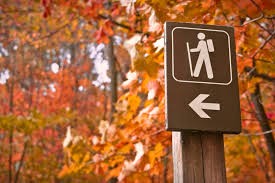 Fall is a great time of year to get outside and enjoy our local parks and hiking trails. The crowds have dissipated, the temperature is just right and the leaves are turning gold and bronze. A relaxing stroll through a peaceful park or trail settles the mind and body. Besides, hiking is a fun, healthy, and affordable. The Grand Traverse Hiking Club is offering a 100 mile challenge which can be completed over weeks or months. Visit them at www.northcountrytrail.org/gtr/ to find out more information. You can also learn about group hikes, the North Country Trail including printable trail brochures and general hiking facts.
Fall is a great time of year to get outside and enjoy our local parks and hiking trails. The crowds have dissipated, the temperature is just right and the leaves are turning gold and bronze. A relaxing stroll through a peaceful park or trail settles the mind and body. Besides, hiking is a fun, healthy, and affordable. The Grand Traverse Hiking Club is offering a 100 mile challenge which can be completed over weeks or months. Visit them at www.northcountrytrail.org/gtr/ to find out more information. You can also learn about group hikes, the North Country Trail including printable trail brochures and general hiking facts.
As with any activity the proper gear and planning can make a walk in the woods an uplifting spiritual experience or a nightmare. Here are guidelines you should follow to get the most out of hiking and remain safe at the same time.
Shoes – A good quality pair of shoes is a must for all physical activity. If you are just starting to hike and plan to stay on smooth level paths, a pair of walking or running shoes will work. Make sure the shoes fit properly and are comfortable. The soles should be sturdy and thick and have good traction to avoid slipping. Once you advance to hiking in areas with hills and rocks you can upgrade to a hiking boot. Again, make sure they are comfortable and don’t rub or compress your feet.
Clothing – Since being outside can be unpredictable you should dress in layers. If the outdoor temperature increases you can shed clothing and add layers when it cools off. A good base layer made from synthetic material will keep you warm and dry. Avoid cotton because it will absorb perspiration making you cold and clammy. A second thin layer should provide some warmth and an outer waterproof layer keeps you dry if it rains. Avoid wearing jeans when hiking because the material is heavy and can chaff your legs when walking for long periods of time. Your socks can be just as important to your feet as your shoes. You might even consider buying hiking socks. These socks are thick and made from synthetic materials to keep your feet dry so you don’t get blisters. If you don’t want to invest in hiking socks just wear a really thick pair you already have or double up and wear two thin pairs.
Safety – In addition to your standard first aid items you will want to bring bug spray and sunscreen. Some scented shampoos, lotions and perfumes attract pesky bugs so don’t use them before hiking. A waterproof sunscreen with SPF of 30 is sufficient to protect your skin. A wide brimmed hat and sunglasses give you a second layer of protection on hikes where there is little to no shade. Don’t forget to apply sunscreen to your ears and protect your lips with an SPF lip balm.
Bring enough water on your hike to keep you hydrated and don’t forget a high energy snack (or two). It is always best to hike with a buddy or at least tell someone where you are going and when you will be back. Bring your cell phone in case you need help.
Know Where You Are Going – It is important to know where you are going on your hike. Take a map and compass to track trail markers and keep yourself oriented in the woods.
For more information on hiking preparedness visit one of the sites below:
www.nerdfitness.com/blog/2011/09/07/hiking/
appalachiantrials.com/beginner-mistakes-backpacking-hiking/
October challenge – Adventure Calls!
What kind of hiker are you? Complete the quiz below and send me the results via email at mtalicska@nmc.edu by November 6th to be entered in a drawing for a local gift card.
www.proprofs.com/quiz-school/story.php?title=what-kind-of-hiker-are-you
